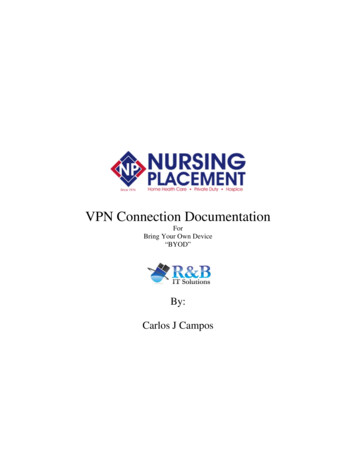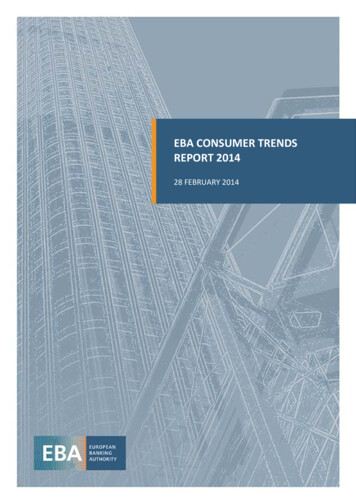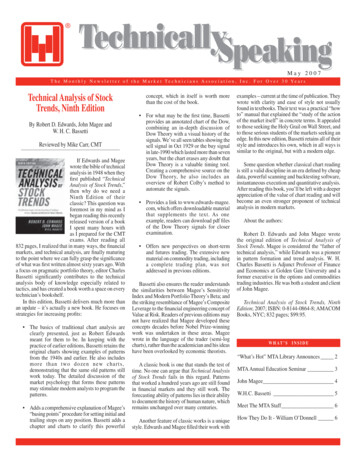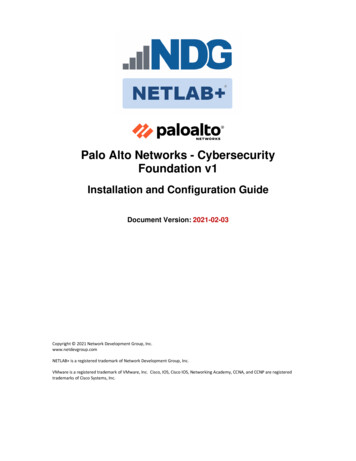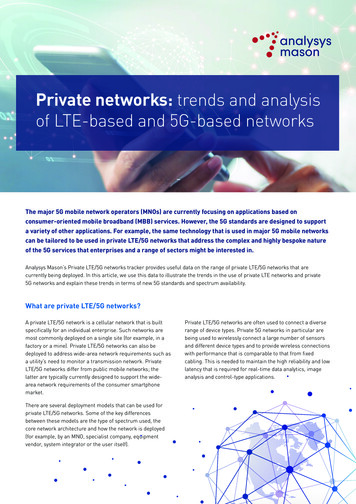
Transcription
Private networks: trends and analysisof LTE-based and 5G-based networksThe major 5G mobile network operators (MNOs) are currently focusing on applications based onconsumer-oriented mobile broadband (MBB) services. However, the 5G standards are designed to supporta variety of other applications. For example, the same technology that is used in major 5G mobile networkscan be tailored to be used in private LTE/5G networks that address the complex and highly bespoke natureof the 5G services that enterprises and a range of sectors might be interested in.Analysys Mason’s Private LTE/5G networks tracker provides useful data on the range of private LTE/5G networks that arecurrently being deployed. In this article, we use this data to illustrate the trends in the use of private LTE networks and private5G networks and explain these trends in terms of new 5G standards and spectrum availability.What are private LTE/5G networks?A private LTE/5G network is a cellular network that is builtspecifically for an individual enterprise. Such networks aremost commonly deployed on a single site (for example, in afactory or a mine). Private LTE/5G networks can also bedeployed to address wide-area network requirements such asa utility’s need to monitor a transmission network. PrivateLTE/5G networks differ from public mobile networks; thelatter are typically currently designed to support the widearea network requirements of the consumer smartphonemarket.There are several deployment models that can be used forprivate LTE/5G networks. Some of the key differencesbetween these models are the type of spectrum used, thecore network architecture and how the network is deployed(for example, by an MNO, specialist company, equipmentvendor, system integrator or the user itself).Private LTE/5G networks are often used to connect a diverserange of device types. Private 5G networks in particular arebeing used to wirelessly connect a large number of sensorsand different device types and to provide wireless connectionswith performance that is comparable to that from fixedcabling. This is needed to maintain the high reliability and lowlatency that is required for real-time data analytics, imageanalysis and control-type applications.
Private networks: trends and analysisof LTE-based and 5G-based networksThe main users of private LTE networks are different to those of private 5G networksOur latest data indicates that a growing variety of applications and sectors are using private networks. A wider range of verticalmarkets are using LTE-based private networks than 5G-based networks, largely because LTE technology has been available forlonger (Figures 1 and 2).Figure 1: Users of LTE-based private networks, worldwide, from data published in June 202119%20%4%Mine3%Factory19%20%PortSmartMine %TransmissionnetworkPortIndustrialplantSmart cityPublicAirportsafety networkRailwayTransmission networkPowerstationIndustrialplantOtherPublic safety networkRailwayPower station7%4%2%3%2%3%7%7%7%11%11%Other10%9%Figure 2: Users of 5G-based private5%networks, worldwide, from data published in June rchcentreMineUniversityFactory campus16%OtherPort15%Research centre46%University campusOther15%16%10%16%10%Nearly half of the 5G private networks that are currently listed in our tracker are deployed in factories. LTE-based private networkuse is more fragmented; the main users include factories, ports and mines.
Private networks: trends and analysisof LTE-based and 5G-based networks5G networks support more-advanced applications than LTE networksLTE-based private networks have mostly been used for MBB connectivity (for example, mobile workforce), industrial equipmentconnectivity and asset tracking, as shown in Figure 3. Private 5G networks are also being used for industrial equipment connectivityand asset tracking, but are additionally used in automatic guided vehicles (AGVs) (Figure 4). These applications use 5G’s low-latencycapabilities to enable real-time data capture, real-time process analysis and intelligent maintenance. Advanced applications canalso make use of the new spectrum that is available for 5G networks that has wider contiguous channels and advanced antennasystems to provide the additional capacity and network performance needed for the most demanding applications.Figure 3: Applications most commonly supported by LTE-based private networks, worldwide, from data published in June 20214%MineFactory7%PortMineSmart cityFactoryAirportPortTransmission network4%2%3%2%3%6%24%6%General connectivityIndustrial equipment24%Asset trackingGeneralconnectivitySmart grid7%7%IndustrialequipmentAGVsAssettrackingNot disclosedSmartcity plantIndustrialAirportPublic safety wer icOther safety networkRailwayPush-to-talkOther71Drones11%Power ity camerasOther7115%Figure 4: Applications most commonly supported by 5G-basedprivate networks, worldwide, from data published in June 20218%14%14%MineFactory8%24%16%Industrial equipmentPortMineResearch centreFactoryUniversity campusGeneral connectivity24%16%Asset trackingGeneralAGVs connectivityIndustrialequipmentNot disclosedPortOtherAssetOther trackingResearch centreAGVsUniversity campusOtherNot disclosed16%Other24%16%24%NlispNalisp
Private networks: trends and analysisof LTE-based and 5G-based networksNew spectrum is enabling additional use cases for private 5G networksAnalysys Mason’s Private LTE/5G networks tracker indicates that private LTE/5G networks use either licensed mobile spectrum,shared access spectrum (such as CBRS spectrum in the USA) or local access licences. The latter are becoming more prevalentwith 5G now that specific bands for local 5G use have been made available in several markets. These bands vary betweendifferent countries, but prominent examples include the 3.7–3.8 GHz band in Germany, the 3.8–4.2 GHz band in the UK and the2570–2620 MHz band in France.1 CBRS spectrum in the 3.5 GHz band has been available for some time in the USA for use in bothLTE and 5G private networks on a shared access basis.Most of the systems listed in Analysys Mason’s tracker are still reported to be using licensed mobile spectrum (that is, spectrumlicensed to MNOs). However, a growing number of private 5G networks are making use of locally licensed spectrum thatregulators have made available to support private network deployments (Figure 5).Figure 5: Type of spectrum used in private LTE/5G networks, worldwide, from data published in June 2021Percentage of private %0%Nationally uropeAmericasAsia–PacificPercentage of private networksThe bands that are typically used vary depending on the market in question. The most commonly used bands for LTE-based and5G-based private networks are shown in Figure 6.57%60%LTE 5GFigure 6: Most commonly used frequency bands for private LTE and 5G networks,50%by region, worldwide,42%42% from data published in June 202140%LTE30%5G2.6 GHz and 3.5 GHz22%3.5 GHz (CBRS)17%20%3.7–3.8 GHz and 3.8–4.2 GHz3.5 GHz and mmWave1800 etworkproviders4%7%28 GHzEnterprises1%3%Systemsintegrators1The European 5G Observatory provides further details on the various approaches to private 5G network spectrum in Europe. European 5G Observatory (2020), 5G private licences spectrum inEurope. Available at: rum-in-europe/.
Private networks: trends and analysisof LTE-based and 5G-based networksPercentage of private networksOne benefit of the new 5G 80%spectrum is that it is better-suited to low-latency applications that need wider channels. This means73%that more-demanding factory-based71%applications could be delivered over wireless 5G links instead of fixedThe use ofLTE cabling.5G70%wireless technology may provide a range of benefits to users, such as greater scalability and flexibility to move or reconfiguremachinery without the constraintsof wired connections. These wider channels are principally available in spectrum bands in the60%3.4–4.2 GHz frequency range, and are not available within the bands most commonly used for private LTE networks, such as 180050%MHz and 2.6 GHz.40%30% getting involved with private25% network deploymentsMNOs are increasingly20%14%MNOs are increasingly getting involved with the deployment8%of private 5G networks (either as network providers or delivery partners)5% that 5G7%due to the complexity of 5G10%technology and the demanding factory and industrial applicationsis being used to support.0%Indeed, for private LTE uipmentproviders(NEPs), whereas there is an0%equal split between the share of systemsmanagedby NEPs andthose managed byMNOs for private Unlicensed5G networks (Figure 7).NationallylicensedLocalSharedspectrumFigure 7: Providers for private LTE and 5G networks, worldwide, from data published in June 2021Percentage of private iders4%7%Enterprises1%3%SystemsintegratorsAnalysys Mason’s consulting team provides strategy, technology, regulatory and spectrum advice inrelation to private networks. This article is based on Analysys Mason’s Private LTE/5G networkstracker. For more information on private networks, see Analysys Mason’s What are private LTE/5Gnetworks and why are they important?
a variety of other applications. For example, the same technology that is used in major 5G mobile networks can be tailored to be used in private LTE/5G networks that address the complex and highly bespoke nature . Push-to-talk Drones Other 8% 24% 24% 16% 16% 14% AGVs Industrial equipment Asset tracking Not disclosed Other General connectivity .


